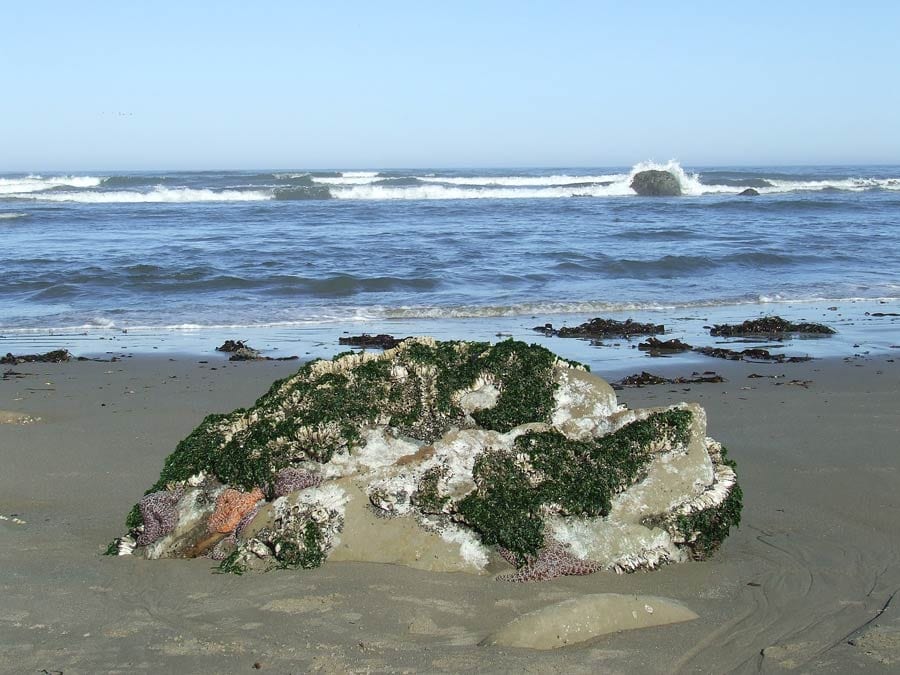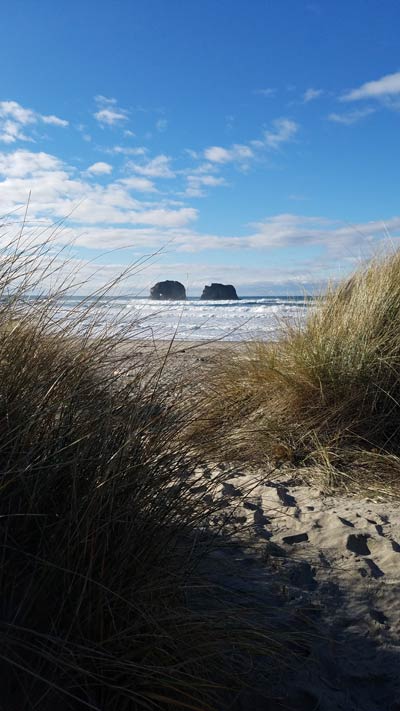




Whether you’re already an avid beachcomber, or you just like to stroll along the coast line and get your feet wet, everyone loves finding those little gems that wash ashore on the beach. It could be sea shells, agates, beach glass or something else entirely.
Here are a few tips and tricks to help you find what you’re looking for when you’re beachcombing in Rockaway Beach.
- When to go. There isn’t necessarily a “best time” to try beachcombing. Whenever you’re at the beach is a good time to walk the shoreline and look for sand dollars, unique shells, softened bits of glass and even artifacts. However, you’ll be most successful right after a winter storm when the Pacific Ocean has jostled loose shells, fossils, sea weed and other rare treasures and tossed them out to dry. It’s still possible to score unique pieces during nice weather though, just aim to go about two hours after high tide (or an hour after low tide) when there is freshly-exposed beach.
- What to wear. It’s no secret that the Oregon Coast can be a bit on the cooler side, even in the summertime. So depending on what time of year it is, it is always a good idea to bring a jacket and good hiking boots. If you’re planning on just staying amongst the flotsam and jetsom, having no-slip shoes won’t make as big of an impact. But if the tide is low enough to check out the tidepools, it can be slippery out there and a good pair of water-proof boots are your best friend. A windbreaker or other zip-up jacket is also a good idea and make sure it has solid pockets for collecting your treasures.
- Pack your tide book. Bummed that you missed the low tide? Well, the great thing about tides is that there is always another low one on the way. True, sometimes the best low tides come in the middle of the night, but chances are if you have your tide book handy you can pick a decent time to head for the beach. If you’re extra lucky, you might even get to experience a minus tide. The serious beachcomber never goes anywhere without his or her tidebook. It’s great for planning when to head out and when you need to start heading back for the shore. The last thing you want to do is be caught off guard by a rapidly increasing high tide.
- Know what to look for. You have your hiking boots, tide book, camera, and even a walking stick but what the heck are you supposed to be looking for? Well, the answer to that is partially personal preference. If it’s eye-catching to you and not harmful to remove from the beach, then it can be considered a successful find. It’s like they say: one man’s trash is another man’s treasure. That can literally be the case when you think about things like beach glass, which is a piece of glass that was thrown away and wound up in the ocean where it was tossed, broken, sanded down, and scattered amongst the rocks. Other things to look for would be shells, driftwood, sand dollars, glass floats, and agates. Agates come in all shapes, sizes, and colors. If you’re hoping to score an agate then pay close attention to gravel beds and creeks that cut into the beach. Wintertime is usually the best season to find these remarkable stones.
- Watch where you step. This one is particularly important if you’re going out on the tide pools. These pools, while fascinating to experience, are the home to many fragile creatures. And just as you wouldn’t want your home to get stepped on, neither do they. It’s ok to look and even get close, but just watch where you’re stepping and avoid crushing any sea animals who are being generous enough to allow visitors into their sanctuary.
- Be safe. We’ve all heard that we should never turn our back on the ocean. The reason is that it’s true. As quickly as the tide goes out it also comes back in, so know what your time limits are when you’re out on the beach and give yourself plenty of time to get back to shore safely. It’s also best not to venture out alone. At the very least, let someone know that you will be out enjoying the low tide.
- Where to go. Not all beaches are created equal. Your best bet will be finding a beach less traveled. Manhattan Beach in Rockaway Beach is a great example. Driftwood likes to pile up here so take your time looking in the unexpected places for shiny and unusual treasures.
- Have fun. Beachcombing takes equal parts patience, timing, and good luck. Because the tides are always moving that means the shoreline is always changing. A fruitless yield at a particular beach one day doesn’t mean it won’t be a gold mine the next day. If you don’t start out your beachcombing trek with expectations about what you’ll find then you won’t be disappointed. Plus, not having expectations might open your eyes to new discoveries that you would have missed otherwise.
You might also be interested in:
The Best Ways to Enjoy Rockaway Beach this Fall
Metal Detecting: Sleuthing Through the Sands of the Tillamook Coast
